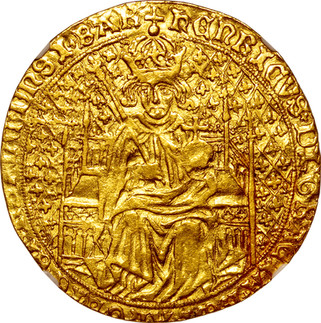Highlights der TAISEI Coins Auktion in Kooperation mit der British Royal Mint am 29. April 2022
- -
- 16. März 2022
- 11 Min. Lesezeit
Aktualisiert: 24. März 2022
View lots and bid for the auction (to be announced): https://auctions.taiseicoins.com/
Contact: auction@taiseicoins.com
Japan
Lot. 71
Japan, Tensho Naga Oban Gold, Original Ink, ND (1573-1591), JNDA# 09-2
PCGS Genuine Graffiti-AU Detail, Pinnacle Collection
Starting Price: 35,000,000 JPY
Toyotomi Hideyoshi, the second “Great Unifier” of Japan, ordered the Goto family to mint Tensho Oban, the first in the series of Oban that would become the largest denomination of Tokugawa coinage in the Edo Period. Tensho Naga Oban is a special and rare type of Tensho Oban, which itself has a special place in the history of the Japanese coinage, making it a sought-after rarity among special rarities. Its shape is vertically longer than that of the regular Tensho Oban and it is the largest pre-modern gold coin in the world. It is extremely rare that the length of a Tensho Naga Oban exceeds 165 mm but surprisingly that of this specimen is 171mm. Both the original ink and the struck surface are in an incomparably superb condition. A real gem among gems.
Lot. 73
Japan, Genroku Oban Gold, Original Ink, ND (1695-1716), JNDA# 09-7
PCGS MS61, Pinnacle Collection
Starting Price: 30,000,000 JPY
Genroku Oban is an Oban whose rarity only seconds Tensho Oban. The character “元” (Gen) is only struck on the reverse side of Genroku Oban among all Obans. The condition of this specimen is incomparable.
Lot. 70
Japan, Silver Pattern Yen, Meiji 3 (1870), KM# Pn16, XF
Starting Price: 5,000,000 JPY
To produce its first modern coinage, the Japanese government asked the British Royal Mint to produce a pattern coinage. This set of pattern coins bear the date inscription Meiji 3 (1870) and their reverse design, the radiating sun rays, differs from those used in the circulating coins issued in Meiji 4. Based on the design drafted by Natsuo Kano at Japan Mint, their master dies with the devise of a dragon were engraved by Leonard Wyon at The British Royal Mint. Two complete sets of The Royal Mint pattern coinage exist and the Yen patterns in these sets are tin strikes. The present specimen is a silver strike. Extremely rare.
Lot. 103
Japan, Gold 20 Yen, Meiji 3 (1870), JNDA01-1
PCGS MS65, Pinnacle Collection
Starting Price: 7,000,000 JPY
The Japanese modern coinage started in Meiji 4 (1879) under the New Coinage Act. However, the earliest gold 20 yen, the highest denomination of the new coinage, bore the date inscription Meiji 3. Unlike the other denominations with the inscription Meiji 4, which are stuck with the devise of a dragon engraved by Natsuo Kano at Japan Mint, the devise of a dragon for this coin is based on the master die engraved by Leonard Wyon at the British Royal Mint.
Great Britain
Lot. 437
England, Henry VII, Gold Sovereign, Type II, ND (ca. November 1492 - spring 1493), Spink# 2173
NGC AU50, The Royal Mint Authentication Label
Starting Price: 100,00,00 JPY
The Birth of the Sovereign
The Wars of the Roses were 30 year-long civil wars fought over the throne of the Kingdom of England between the House of Lancaster and the House of York in the 15th century. And in the Battle of Bosworth, Henry VII of Lancaster defeated Richard III of York, becoming the last British monarch who rose to the throne by a battle. Henry VII (Reign: 1485 -1509) married Elizabeth of York, solving the animosities caused by the Wars of the Roses between the two Houses and stabilizing his monarchic status, and established the Tudor dynasty with Elizabeth.
The first gold sovereign, weighing 240 grains and equivalent to 20 shillings, was issued by Henry VII to achieve financial stability of the new dynasty and became the origin of the today’s British currency pound. There are five types of the Henry VII’s hammer-struck sovereigns. Only one example of the oldest Type I (Spink# 2172) is known to exist and it is in the collection of the British Museum. The present specimen is a Type II (Spink# 2173), the second oldest type. Four examples of this type are known to exist and two of these are in museums. The present specimen is one of the two examples that are privately owned, the other being the ex- Herbert Schneider piece.
The Tudor rose, the central device on the reverse, is the heraldic emblem of England that combines the red rose, the symbol of the House of Lancaster, and the white rose, the symbol of the House of York, and symbolizes the monarchic legitimacy of Henry VII who ended the Wars of the Roses. Among the differences between Type I and Type II are the fleur-de-lis only used behind the seated king in Type II and the cross fitchée mint mark of Type II.
Henry VII (1485-1509), fine gold Sovereign of Twenty Shillings, struck Tower Mint London, Group II (issued circa November 1492 – Spring 1493), full seated facing robed figure of King on throne with narrow back, holding orb and sceptre, hatched background of fleur de lis, cross on crown breaks beaded inner circle, legend surrounding, hEnRICVS’x DIx GRACIAx REXx AnGLIEx ETx FRAnCx DnS Ix BAR’, saltire stops with chevron barred As, rev.quartered shield of arms at centre of Tudor rose, within a beaded and linear tressure of ten arcs, trefoil in each spandrel, beaded border and legend surrounding, initial mark cross fitchée, IhC AVTEm: TRAnCIEnS. PER. mEDIVm: ILLORVm: IBAT nE, trefoil stops with chevron barred As, weight 15.27g, 235.6 grains (Grierson class B, p.120 no 2, this coin; P&W I, plate X no.1; Schneider 548; N.1689; S.2172). Of crisp bright appearance, a little short of flan, otherwise a bold very fine and of the highest rarity, one of only four examples known and only one of two in private ownership.
Provenance
Ex John Alfred Wigan and Edward Wright Wigan Collection, purchased post mortem by Rollin and Feuardent, 1872.
Ex Sir John Evans, died 1908, collection purchased by Spink portion of collection sold to J. P. Morgan.
Ex John Pierrepont Morgan, died 1913, portion of collection sold by his son 1915 to R. C. Lockett.
Ex Richard Cyril Lockett, English Coins part 2, Glendining, 11-17th October 1956, lot 1667, plate XVI, sold for £1,400.
Ex R. Duncan Beresford-Jones, Spink Coin Auction 29, 2nd June 1983, lot 22, sold for £36,000 hammer.
Ex Thomas H Law Collection, Stacks Bowers Ponterio, Auction 176, 13th August 2013, lot 20047.
Lot. 439
England, Henry VIII, Gold Sovereign, 3rd Coinage, Southwark Mint, ND (1544-1547), Spink# 2219, NGC XF40, The Royal Mint Authentication Label
Starting Price: 3,000,000 JPY
There are three types of the Henry VIII gold sovereign and the present specimen is the third type that was struck between 1544 and 1547. The coins of the third type were struck at the Tower Mint, the Bristol Mint and the Southwark Mint, the last of which was opened under Henry VIII and closed under Mary I, his daughter. The present specimen is a Southwark Mint variety and the mint mark “S” is struck.
Henry VIII (1509-47), gold Sovereign, third coinage (1544-47), Southwark Mint, initial mark S both sides, facing crowned robed figure of King on ornate throne, rose below, 8 type legend with Gothic lettering and beaded border surrounding, slipped trefoil stops, hEnRIC; 8; DI; GRA; AGL', ++ FRAnCIE; Z; hIBERn'; REX, rev. crowned quartered shield of arms, with lion and dragon supporters, HR ligatured on banner below, Latin legend with Roman lettering and beaded border surrounding, IhS; AVTEM; TRAnSIEnS; PER MEDIVM; ILLOR; IBAT;, weight 12.18g (SCH 611; N.1825; S.2291). Weakly struck in parts both sides but with important detail clear, has been slabbed and graded by NGC as XF40.
Lot. 446
Commonwealth of England, English Shield, Silver Crown, 1656, KM# 392
NGC MS62, The Royal Mint Authentication Label
Starting Price: 900,00 JPY
During the Wars of the Three Kingdoms between 1639 and 1653, the Kingdoms of England, Scotland and Ireland abolished the monarchy and founded the Commonwealth of England. Therefore the Commonwealth coinage does not bear effigies of monarchs but uses an English shield on the obverse and English and Irish shields on the reverse as the central devices. The legends are not in Latin but in English.
Commonwealth (1649-60), silver Crown, 1656, second 6 struck over small 6 struck over 4, English shield within laurel and palm branch, legends in English language, initial mark sun, .THE. COMMONWEALTH. OF. ENGLAND., the second N struck over an inverted N, rev. English and Irish shields, value .V. above, beaded circle and legend surrounding, date at top, GOD. WITH. VS., the V of VS possibly an inverted A, 30.30g (Bull 14 R3; ESC 8A; N.2721; S3214). Attractively toned, well struck and well centred, extremely fine and rare this nice, especially for the varieties.
Lot. 450
Charles II Silver Pattern Petition/Reddite Crown, ND (1663), KM# PnB33, Bull# 435
NGC MS61, Bull Plate, The Royal Mint Authentication Label
Starting Price: 1,800,000 JPY
Thomas Simon, the chief engraver of the British Royal Mint during the Commonwealth era, created the “Petition Crown,” a pattern crown he produced in petition to the coinage with the effigy of Charles II that was engraved by another engraver after the Stuart Restoration. Among this, the one with the word “petition” on the edge is commonly called the Petition Crown and the one with the Latin word “Reddite” the Reddite Crown. The present specimen has only its obverse Charles II effigy side struck and on the flat reverse is a hand-engraved description including the Simon’s name. It is thought to be one of the patterns struck with the die of the Petition/Reddite Crown. This unique specimen, only one example known to exist, is struck on a thin piece of silver which was then mounted on a thick silver plate, resulting in the waving on the obverse. The certification label states: “Bull-435 CLICHE.” Since 1955, this coin had been customarily described as “cliché,” which means electrotype, and the Spink’s important English Silver Coinage edited by Maurice Bull labels it so. But, as explained above, this customary label is improper as a factual description. The present specimen is the very coin photographed in the Bull catalog.
Charles II (1660-85), uniface undated obverse striking for the Pattern Crown, struck on a thin silver flan, seemingly an early die trial for the Petition and Reddite Crowns of 1663, engraved by Thomas Simon, laureate and draped bust right, legend and toothed border with some triangular denticles beyond surrounding, CAROLVS II. DEI. GRA, Simon italic signature below bust, design and lettering shaded and frosted giving enhanced texture to the raised elements, the whole obverse presented and fixed in a metal disc of crown size and thickness of later manufacture, rev. the metal disc engraved with a six-line italic legend, raised rim surrounding, A proof / in thin silver / of the finest coin / ever engraved / in England / by T. Simon., edge plain, weight 16.41g (L&S 9; Lessen plate 7, No.7; Bull 435).
Lot. 483
Great Britain, George III “Three Graces,” Silver Proof Pattern Crown, 1817, KM# PnB77, ESC# 2020
NGC PF65, The Royal Mint Authentication Label
Starting Price: 25,000,000 JPY
The “Three Graces,” one of the most popular coins in the world, was engraved by William Wyon, one of the most famous coin engravers in the world. It is a pattern coin Wyon submitted to the British Royal Mint for a competition with Benedetto Pistrucci, another great engraver. Wyon lost. So only 50 “Three Graces” were minted. Its special popularity is based on both its beauty and rarity. Wyon based his design on the Antonio Canova’s Neoclassical marble sculpture “Three Graces.” While the Canova’s piece takes its subject from Greek mythology, Wyon made his Three Graces represent Britain, Scotland and Ireland by adding the attributes the Union flag, a harp and a thistle respectively beside the female figures. The deep and exquisite strike is a result of the recently invented steam-powered minting machine. PF65 is the highest grade designated for this coin so far.
Lot. 493
Great Britain, Victoria Young Head, Gold Proof “Shield” Sovereign, 1839, KM# 736.1, Spink# 3852
NGC PF66★ ULTRA CAMEO, The Royal Mint Authentication Label
Starting Price: 800,000 JPY
There are few Victoria gold sovereigns that have been graded higher than the present specimen’s PF66★. And it is the highest so far for this year. A treasure handed down in a superb condition.
Lot. 510
Great Britain, Victoria Young Head, Gold Proof “St. George” Sovereign, Medal Alignment, 1871, KM# 752, Spink# 3856
NGC PF65 ULTRA CAMEO, The Royal Mint Authentication Label
Starting Price: 700,000 JPY
There are only a number of Victoria gold sovereigns that have been graded higher than the present specimen’s PF65. A treasure handed down in a superb condition.
Lot. 525
Great Britain, George V, Silver Matte Proof Pattern Crown, 1910, ESC# 3658
NGC PF63 MATTE, The Royal Mint Authentication Label
Starting Price: 1,400,000 JPY
The astonishingly novel design of Saint George and the Dragon and the stunning effigy of George V with beautifully engraved hair and beard were works by Allan G. Wyon at the British Royal Mint. His initials A.G.W. are struck on the reverse side of this pattern coin. Only 10 pieces were minted.
China
Lot. 218
China, Qing Dynasty, Shanghai, Crowned Coat of Arms of the Great Britain, Silver Proof Pattern Tael, With Rays, 1867, KM# Pn125, Kann# 912, NGC PF63+
Starting Price: 6,000,000 JPY
Commissioned by the Shanghai's Industrial Bureau, this coin was minted at Hong Kong Mint as a pattern coin for the Chinese unified currency and uses the currency unit tael that was circulating in Shanghai. The design of the coin is distinguished by its British elements but the Chinese central government rejected the design and most of the specimens were melted down. There are two types of this coin — one with rays and the other without rays around the central device of a dragon — and only 2-3 specimens are known to exist for each type. A superb condition.
Lot. 219
China, Qing Dynasty, Guangxu Yuanbao Silver Restrike Pattern Tael, Year 29 (1903), KM# Pn295, Kann# 927, NGC MS63
Starting Price: 4,000,000 JPY
In 1903, the Chinese government had pattern coins minted for the currency reform that was to adopt the gold standard. The master dies for these pattern coins with five different denominations were produced at the Osaka Mint by the Japanese government. The present specimen is the highest denomination of these. Today, it is known that the original and the restrike can be distinguished for these pattern coins by their strike characteristics. However, they were not distinguished until recently and, even today, a restrike does not necessarily have “RESTRIKE” on its certification label. It has been theorized that the restrikes were minted around the early 1950s when such restrikes were produced or sold to King Farouk.
Lot. 269
Republic of China, Chang Tso-lin, Silver Pattern Dollar, ND (1927), Kann# 687
NGC MS62 Ex. Kann/Kann Plate
Starting Price: 20,000,000 JPY
A Rarity in the Legendary Modern Chinese Coin Catalog
The Chang Tso-lin pattern coinage minted at the Tianjin Mint is a special rarity among modern Chinese coins. There are four types of Chang Tso-lin silver dollars that are known to exist and they are listed in the Eduard Kann’s important modern Chinese coin catalog as Kann# 685-688. Recently, two specimens of Kann# 688 were sold at major auction houses and set the highest prices for modern Chinese coins, both exceeding 2,000,000 USD. The present specimen is Kann# 687 and Ben Wengel of NGC has traced its pedigree to both the 1971 Schulman sale of the Kann Collection, as well as a 1972 Jess Peters catalog where the coin was listed as being from the Kann Collection and the plate coin in the Kann catalog. This coin is one of only two examples we were able to trace after extensive searching in reference works and auction catalogs.
Others
Lot. 580
Hong Kong, Victoria, Silver Proof Dollar, Plain Edge, 1866, KM# 10, NGC PF64
Starting Price: 200,000 JPY
This attractively designed coin was minted at the Hong Kong Mint to be used in the place of the Mexican silver dollar that was circulating in Hong Kong at the time. But the Chinese reception of the coin was not good and it was only minted between 1866 and 1868. As a result, the Hong Kong Mint was closed down and its minting machinery was sold to the recently established Osaka Mint in Japan. There are four types of the proof version of this coin — Reeded Edge/Coin Orientation, Reeded Edge/Medallic Orientation, Plain Edge/Coin Orientation and Plain Edge/Medallic Orientation. This specimen is a superb example of the Plain Edge/Medallic Orientation type.
Lot. 641
German New Guinea, Bird of Paradise, Silver Proof 5 Mark, 1894, KM# 7
NGC PF63, The Paramount Collection
Starting Price: 1,500,000 JPY
The silver 5 mark “Bird of Paradise,” including its MS strikes, were produced with the mintage of 23,000. But after its withdrawal from circulation, 19,000 were melted down, making the coin extremely scarce. This specimen is a superb proof strike of this famous coin.
Lot. 642
German New Guinea, Bird of Paradise, Gold Proof 10 Mark, 1895, KM# 8
NGC PF65 CAMEO, The Paramount Collection
Starting Price: 8,000,000 JPY
Considered to be one the most beautiful coins in numismatic history. Superb proof condition.















































































































Kommentare